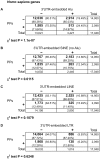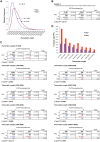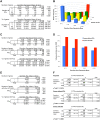Novel Role of 3'UTR-Embedded Alu Elements as Facilitators of Processed Pseudogene Genesis and Host Gene Capture by Viral Genomes
- PMID: 28033411
- PMCID: PMC5199112
- DOI: 10.1371/journal.pone.0169196
Novel Role of 3'UTR-Embedded Alu Elements as Facilitators of Processed Pseudogene Genesis and Host Gene Capture by Viral Genomes
Abstract
Since the discovery of the high abundance of Alu elements in the human genome, the interest for the functional significance of these retrotransposons has been increasing. Primate Alu and rodent Alu-like elements are retrotransposed by a mechanism driven by the LINE1 (L1) encoded proteins, the same machinery that generates the L1 repeats, the processed pseudogenes (PPs), and other retroelements. Apart from free Alu RNAs, Alus are also transcribed and retrotranscribed as part of cellular gene transcripts, generally embedded inside 3' untranslated regions (UTRs). Despite different proposed hypotheses, the functional implication of the presence of Alus inside 3'UTRs remains elusive. In this study we hypothesized that Alu elements in 3'UTRs could be involved in the genesis of PPs. By analyzing human genome data we discovered that the existence of 3'UTR-embedded Alu elements is overrepresented in genes source of PPs. In contrast, the presence of other retrotransposable elements in 3'UTRs does not show this PP linked overrepresentation. This research was extended to mouse and rat genomes and the results accordingly reveal overrepresentation of 3'UTR-embedded B1 (Alu-like) elements in PP parent genes. Interestingly, we also demonstrated that the overrepresentation of 3'UTR-embedded Alus is particularly significant in PP parent genes with low germline gene expression level. Finally, we provide data that support the hypothesis that the L1 machinery is also the system that herpesviruses, and possibly other large DNA viruses, use to capture host genes expressed in germline or somatic cells. Altogether our results suggest a novel role for Alu or Alu-like elements inside 3'UTRs as facilitators of the genesis of PPs, particularly in lowly expressed genes. Moreover, we propose that this L1-driven mechanism, aided by the presence of 3'UTR-embedded Alus, may also be exploited by DNA viruses to incorporate host genes to their viral genomes.
Conflict of interest statement
The authors have declared that no competing interests exist.
Figures








Similar articles
-
Multiple Alu Exonization in 3'UTR of a Primate-Specific Isoform of CYP20A1 Creates a Potential miRNA Sponge.Genome Biol Evol. 2021 Jan 7;13(1):evaa233. doi: 10.1093/gbe/evaa233. Genome Biol Evol. 2021. PMID: 33434274 Free PMC article.
-
Whole-genome screening indicates a possible burst of formation of processed pseudogenes and Alu repeats by particular L1 subfamilies in ancestral primates.Genome Biol. 2003;4(11):R74. doi: 10.1186/gb-2003-4-11-r74. Epub 2003 Oct 28. Genome Biol. 2003. PMID: 14611660 Free PMC article.
-
The majority of endogenous microRNA targets within Alu elements avoid the microRNA machinery.Bioinformatics. 2013 Apr 1;29(7):894-902. doi: 10.1093/bioinformatics/btt044. Epub 2013 Jan 29. Bioinformatics. 2013. PMID: 23361327
-
Short interspersed nuclear element (SINE)-mediated post-transcriptional effects on human and mouse gene expression: SINE-UP for active duty.Philos Trans R Soc Lond B Biol Sci. 2020 Mar 30;375(1795):20190344. doi: 10.1098/rstb.2019.0344. Epub 2020 Feb 10. Philos Trans R Soc Lond B Biol Sci. 2020. PMID: 32075563 Free PMC article. Review.
-
ALUternative Regulation for Gene Expression.Trends Cell Biol. 2017 Jul;27(7):480-490. doi: 10.1016/j.tcb.2017.01.002. Epub 2017 Feb 10. Trends Cell Biol. 2017. PMID: 28209295 Review.
Cited by
-
Identification of a minimal Alu domain required for retrotransposition.bioRxiv [Preprint]. 2024 Dec 16:2024.12.16.628748. doi: 10.1101/2024.12.16.628748. bioRxiv. 2024. Update in: Nucleic Acids Res. 2025 Jun 20;53(12):gkaf526. doi: 10.1093/nar/gkaf526. PMID: 39868163 Free PMC article. Updated. Preprint.
-
SARS-CoV-2 helicase might interfere with cellular nonsense-mediated RNA decay: insights from a bioinformatics study.BMC Genom Data. 2023 Nov 18;24(1):68. doi: 10.1186/s12863-023-01173-y. BMC Genom Data. 2023. PMID: 37980504 Free PMC article.
-
Transposable element expression and sub-cellular dynamics during hPSC differentiation to endoderm, mesoderm, and ectoderm lineages.Nat Commun. 2025 Aug 18;16(1):7670. doi: 10.1038/s41467-025-63080-3. Nat Commun. 2025. PMID: 40825949 Free PMC article.
-
Identification of a minimal Alu domain required for retrotransposition.Nucleic Acids Res. 2025 Jun 20;53(12):gkaf526. doi: 10.1093/nar/gkaf526. Nucleic Acids Res. 2025. PMID: 40568936 Free PMC article.
-
Divergent Traits and Ligand-Binding Properties of the Cytomegalovirus CD48 Gene Family.Viruses. 2020 Jul 28;12(8):813. doi: 10.3390/v12080813. Viruses. 2020. PMID: 32731344 Free PMC article.
References
-
- Vassetzky NS, Ten OA, Kramerov DA. B1 and related SINEs in mammalian genomes. Gene. 2003;319:149–60. - PubMed
MeSH terms
Substances
Grants and funding
LinkOut - more resources
Full Text Sources
Other Literature Sources
Miscellaneous

